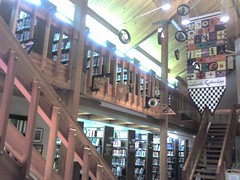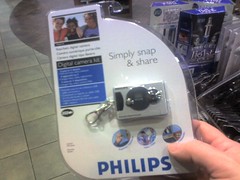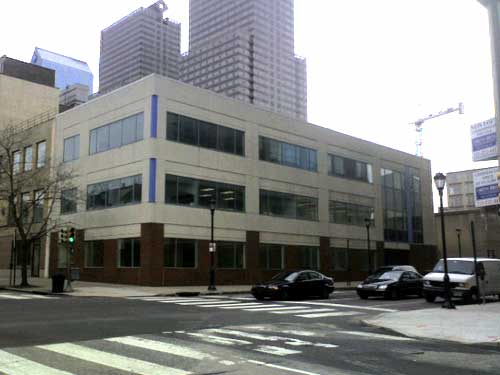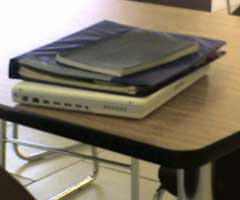 |
| This is a picture I took last night, during my interview with Martin. It’s an auction house where WOW players can auction off their items for currency.
|
I got my first comment in ages on Connect Learning (my occasionally posted podcasts) last night, only minutes after the podcast was uploaded. The program is an interview with my son, Martin, while he’s playing the video game, World of Warcraft. It’s an enormously popular MMORPG, evidenced by the 48 item bibliography in its Wikipedia article. By the way, MMORPG stands for Massively Multiplayer Online Role-Playing Game. Please go over and give the podcast a listen, and see some of the pictures I too with my phone during the interview. There isn’t a lot of education value to the podcast, other than trying to illustrate the compelling nature of these games — resulting in edu-blogger, Tom Turner’s comment.
Connect Learning, with David Warlick » Episode 77 — A Tour of World of Warcraft:
EGADS…World of Warcraft. Played for 2 years plus 6 months of beta testing before release! I’m glad to have gotten that monkey off my back when I quit playing back in late September. I can honestly say that quitting has been the best thing for me…I’m concentrating more on my classroom, researching and reading blogs such as this and really pushed me to beginning my own blog.
I have to admit a certain amount of disappointment and apprehension when Martin mentioned a couple of months ago that he was playing video games again. He was nearly obsessive about it a few years ago, though, as he mentioned in the podcast, he likes to get out and do stuff with his friends. I’m not worried. His passion is music, which is his college major, and I really don’t worry about anything getting in the way of that — and as I implied in yesterday’s blog, there are probably worse things that I could be worried about.
My interest continues to be in examining what it is that is so compelling about these video games, and how do we implement these elements into how we run our classrooms, to make them (nearly) as compelling.
It all takes me back to an age before WWW. The dark ages of FTP, Gopher, telnet, and something called M.U.D.s or Mult-User Domains. They were quite similar to World of War Craft, except that in the primitive days before Netscape and Internet Explorer (and their grandfather, Mosaic), there were no graphics. It was all text-based.
OK, picture this ;-). You connect to a host server through Telnet (don’t worry about it), and you sudden read a paragraph that describes in carefully selected adjectives, an office, with paneled walls, victorian furniture, and a large oak desk. On the desk you see …. You get the picture. What’s more, at the bottom of the description is a list of commands you can issue. Go north (if there’s a door to the north), go south, pick up diary, open drawer, … It is fully interactive, and if you enter a room where other people (logged in through Telnet) are exploring, they and their description become part of the landscape and you can talk to them and emot gestures. I was usually a tall black man with dreadlocks, dressed in a gray sport coat, starched white shirt, and dingy bluejeans. It was compelling and it was a scandal as kids were flunking out of college because they spent their waking hours in MUDS.
Yet there were some very interesting things going on in the world of education. MIT had a MUD called MediMOO. I had an office there and attended meetings and discussions with other educators who were exploring the education applications. Specifically, we were interested in building worlds in these MUDs that might be educationally beneficial to students. Our capital newspaper, the News & Observer, who hosted one of the first three ISPs in North Carolina, established a MUD, and I built a museum there called The Museum of Imagination. Students were invited to come to the museum, and contribute their own exhibits. In each room was a wire bin, holding what were called generic exhibits. If a student wanted to contribute an 18th century printing press (much of the theme was about new reporting), then they could pick up a generic exhibit, and attach the description of a two-hundred year old printing press. Then drop the exhibit in the room where visitor could see (read) it. There was also the Hall of a Hundred Haikus. Students could pull a cube from the ceiling of the hall, write an original haiku on it, and put it back, contributing their own haiku cube for others to read. There was also a museum cafe with robotic waiters with an attitude. The Couscous was wonderful 😉
A group at the University of Arizona took it ten steps forward when they invited a group of at-risk, previously suspended middle school students into a MUD that was essentially flat asphalt. The kids were asked to build a city for themselves. These students, whom you couldn’t get to write their names in a traditional classroom, wrote megabytes that summer, as they built their homes and city by describing them in the MUD. Educators from around the world attended to mentor the students online. I got to attend their online, MUD-based graduation, and their parents attended as well in real life. Most of these parents had never been invited to school for anything except discipline issues. Several of them commented that their children, for the first time, were coming home talking for hours about school.
In 1992, I interviewed some of the teachers involved in this project in my office at MIT’s MediaMOO. I had a virtual camera in the room which recorded the entire (text-based) conversation. I included this interview in the first couple of editions of Raw Materials for the Mind. You can read a PDF copy of it here.
This was really cool stuff. What if we had an MMORPG that started with flat asphalt, and asked students to build their world around their curriculum?
2¢ Worth
Technorati Tags: warlick technology mmorph muds mediamoo
 Joe Poletti, at Haulin’ ‘Net describes some of the senior projects that were presented recently in Carteret County.
Joe Poletti, at Haulin’ ‘Net describes some of the senior projects that were presented recently in Carteret County.








